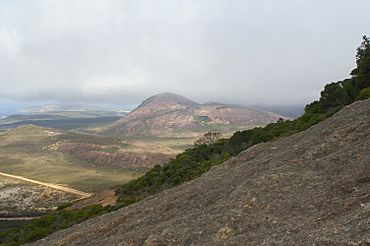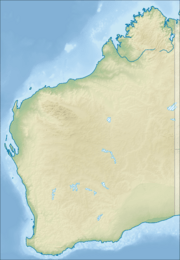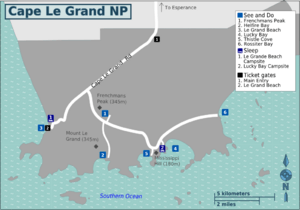Cape Le Grand National Park facts for kids
Quick facts for kids Cape Le Grand National ParkWestern Australia |
|
|---|---|
|
IUCN Category II (National Park)
|
|

Mount Le Grand from Frenchman Peak
|
|
| Nearest town or city | Esperance |
| Established | 1966 |
| Area | 318.01 km2 (122.8 sq mi) |
| Managing authorities | Department of Parks and Wildlife |
| Website | Cape Le Grand National Park |
| See also | List of protected areas of Western Australia |
Cape Le Grand National Park is an amazing national park in Western Australia. It's about 631 kilometers (392 miles) south-east of Perth. It's also 56 kilometers (35 miles) east of Esperance.
This park covers a huge area of 31,801 hectares. That's like 318 square kilometers! The land here is super old. It has been above sea level for over 200 million years. It was never covered by glaciers. Because of this, the park is home to many ancient plant and animal species. These are called relict species.
The park was created in 1966. The Department of Parks and Wildlife looks after it. The name "Le Grand" comes from an officer. He was on a ship called L'Espérance in 1792. This ship was part of an expedition led by Bruni d'Entrecasteaux.
Contents
Exploring Cape Le Grand
The park has beautiful granite shorelines. Its white sand beaches are very famous. People love to visit for many fun activities. You can go fishing here. Some visitors enjoy off-roading on certain tracks. It's also a great spot for tourism and hiking.
There are several stunning beaches inside the park. These include Lucky Bay, Rossiter Bay, Hellfire Bay, Le Grand Beach, and Thistle Cove. South of the park, you'll find islands and waters. This area is called the Recherche Archipelago Nature Reserve. It's another protected part of the Recherche Archipelago. The Cape Arid National Park is located to the east.
The south-west part of the park has many rock formations. These are made of gneiss and granite. They form a chain of cool peaks. These include Mount Le Grand (345 meters or 1,132 feet tall). There's also Frenchman Peak (262 meters or 860 feet). Mississippi Hill is 180 meters (591 feet) high. It's named after a French whaler ship called the Mississippi.
Further inland, the park changes. It has mostly sandy plains covered with heath plants. You'll also find swamps and fresh water pools.
Amazing Animals and Plants
The sandy plains are home to many banksia plants. You can see Banksia speciosa and Banksia pulchella.
Other plants in the park include Melaleucas and Grevilleas. There are also sheoaks and the Christmas tree. You might also spot grass trees. Wildflowers are most beautiful in the Australian spring. This is usually until October. You can see blue china orchids (Cyanicula gemmata). Other flowers include Diuris corymbosa and Hakea laurina. You might also find Thysanotus sparteus and Thelymitra macrophylla.
Many animals live in the park. You might see bandicoots and pygmy honey possums. There are also ring-tailed possums and quenda. Western grey kangaroos are also common here.
Some very old species live in the park. These are relict species with links to the ancient supercontinent Gondwana. They include legless lizards. Examples are the common scaly-foot (Pygopus lepidopodus). You can also find Delma fraseri, Delma australis, and Aprasia striolata. An ancient blind snake, Ramphotyphlops australis, also lives here.
Frogs found only in this area include the |quacking frog (Crinia georgiana). There's also the banjo frog (Limnodynastes dorsalis). And don't forget the humming frog (Neobatrachus pelobatoides).
Things to Do and Places to Stay
Cape Le Grand National Park has good facilities for visitors. You'll find toilets and barbecues. There are also campsites and tables. Sheltered areas are available for picnics. You can explore many walk-trails. Information bays help you learn more about the park. There are also water tanks.
Two full-time rangers live in the park. They help manage the area. During busy holidays, a 'camp host' couple also helps out. You can check the Cape LeGrand Campground website for booking details.
Gallery
See also
 In Spanish: Parque nacional Cabo Le Grand para niños
In Spanish: Parque nacional Cabo Le Grand para niños







